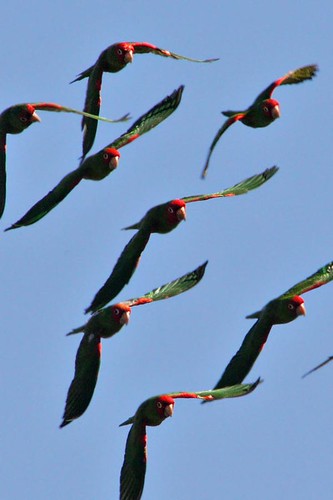tags: animal adoption, pets, birds, parrots, Wild Parrots of Telegraph Hill, San Francisco
In response to an email I received on Sunday morning, I wrote a short plea for help finding homes for some of San Francisco's famous Telegraph Hill parrots. But the situation these birds face was far from clear, so I did some investigating to learn more about these birds' plight.
For those who might not be familiar with them, these parrots were made famous by the 2005 documentary, "The Wild Parrots of Telegraph Hill," [regular people's DVD and collector's DVD] based on the 2004 book with the same name by Mark Bittner [paperback]. These parrots are mentioned in numerous San Francisco travel guides, are visited by tourist tour groups, and they even have a local fan club.
Unfortunately, people seem to be loving these birds to death. Finally, in 2007, the city of San Francisco stepped in and banned parrot feeding because they were eating too many dried seeds -- birdie junk food. Because of these easy picking, the parrots were not getting a diet that was rich in fresh foods such as fruits, flowers, leaves and shoots, and they were becoming ill with a bone disease. The birds were also so dependent upon people that they were becoming easy targets for predators.
How did these birds come to live in San Francisco? This is the source of plenty of speculation, but the original birds might have been escapees. According to Bittner, the musician who devoted years to chronicling and caring for these feral parrots, there were just four birds in 1989; a breeding pair and their two offspring. In the ensuing years, the flock increased their numbers. There were 26 parrots in 1994, and 50 in 1999.
However, it appears that these birds had some help increasing their numbers -- from humans. Currently, the Telegraph Hill flock consists of cherry-headed (red-masked) conures, Aratinga erythrogenys, mitred conures, Aratinga mitrata, blue-crowned (sharp-tailed) conures, Aratinga acuticaudata, and now, a peculiar assortment of hybrids between these species.
This growth in parrot numbers led to a few problems. But a local bird rescue organization, San Francisco's Mickaboo Companion Bird Rescue, provides care and homes to a small minority of these feral parrots when they need it. These needy birds include fledglings that break bones while learning to fly and to live independently, as well as adult birds stricken by injury or illness.
One illness that the parrots are sickened by is a round worm commonly found in raccoon feces, according to Jennifer Erlichman, a fashion designer and Mickaboo's conure contact person (conures are the type of parrots that comprise San Francisco's Telegraph Hill flock). This worm, Baylisascaris procyonis, causes a neurological disease characterized by dizziness and the inability to fly. After they are infected by this worm, most of the birds succumb to the disease.
Mickaboo is a 501(c)3 non-profit volunteer-only organization that was originally founded to provide temporary shelter and medical care to neglected, abused, injured or abandoned pet cockatiels, but it is now inundated with these feral Telegraph Hill parrots.
"We're getting more birds and losing more adoptive homes because of the recession," remarked Erlichman, who is currently fostering five cherry-headed conures, in addition to her pet parrot that she adopted seven years ago.
Mickaboo volunteers are providing temporary housing to 18 of the Telegraph Hill parrots. This is the largest number of these feral parrots they've ever had, and because the organization has no central facility, every bird is sent to an individual foster home. At this time, Mickaboo is seeking more volunteers to foster these birds while they receive veterinary care until they can either be released or adopted.
If you can help by providing a foster or adoptive home, if you are a local veterinarian who can provide free/reduced cost medical care, or if you are a private citizen who can provide other supplies, materials or skills, please contact volunteer@mickaboo.org.
[One suggestion of mine is to encourage a local "someone" with a digital camera to photograph all of Mickaboo's birds so they can fill their site with loads of images of "their" birds (or, if you are seeking to "rehome" a digital camera, why not pack it up and send it off to Mickaboo as a donation?)]


Very sad. Great documentary.
Someone on another message board made an interesting point:
If/when these parrots discover the vineyards in the North Bay, the public's tolerance for them is going to be put to the test.
A large group of them has been hanging out in my neighborhood (and my yard) this week in the Inner Sunset. We may need to call them the parrots of Grand View Park.